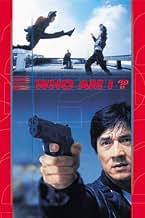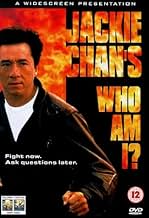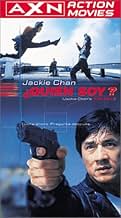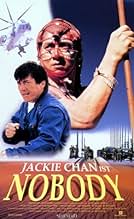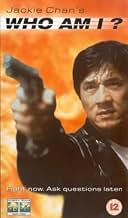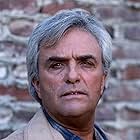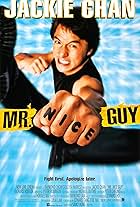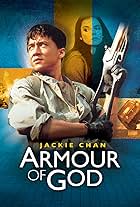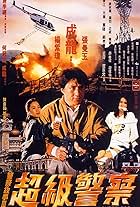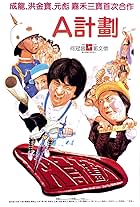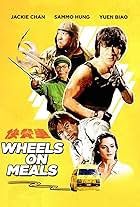Un agente segreto perde la memoria dopo essere caduto da un elicottero che si è precipitato a terra. Viene quindi inseguito da molti altri agenti della stessa agenzia, ma non ha idea del per... Leggi tuttoUn agente segreto perde la memoria dopo essere caduto da un elicottero che si è precipitato a terra. Viene quindi inseguito da molti altri agenti della stessa agenzia, ma non ha idea del perché.Un agente segreto perde la memoria dopo essere caduto da un elicottero che si è precipitato a terra. Viene quindi inseguito da molti altri agenti della stessa agenzia, ma non ha idea del perché.
- Premi
- 2 vittorie e 10 candidature
- CIA Chairman
- (as Tom Pompert)
- CIA Secretary
- (as Gloria Simon)
- Airforce
- (as Johan van Ditmarsch)
- Marine Assistant
- (as Jeremiah Flemming)
Trama
Lo sapevi?
- QuizMichelle Ferre never considered acting, but on the set of this movie, when she tried to interview Jackie Chan, he was struck by her, and asked her to audition for the movie, which she did, and landed a co-starring role.
- BlooperWhen Jacki runs up the hill on top of the rocks and screams, "Who am I?" you can see a member of the crew underneath the bridge area. When the chopper shot starts to move around you can see him look up at the camera and move back under the bridge trying to hide.
- Citazioni
Morgan's hitman: You've got two choices. Give us the disk and jump off.
Morgan's Hitman: Or number two, we take the disk and throw you off.
Who Am I?: I like the third choice: I keep the disk, and I throw you both off.
- Curiosità sui creditiIn the tradition of every Jackie Chan film, outtakes appear under the end credits. All of Jackie's outtakes involve bloopers only. The only injury on the outtakes is a stunt driver being brought out on a stretcher.
- Versioni alternativeThe American version is cut by 9 minutes. Scenes omitted from the American version: -In the Hong Kong version, we do not see Jackie's unit get double crossed right after the mission is over (The American edit shows the unit getting double crossed after the mission). When the mission is over, it immediately cuts to the CIA briefing room. The scene with the double cross is shown during a flashback.
- There are more scenes with Jackie and his time with the African tribe. These include:
- Jackie talks in Chinese most of the time (The American version shows him talking in English as the film was shot in English).
- A conversation with tribal child Baba about the sun and the moon in hopes of finding out what happened to him.
- A confrontation with Jackie and a lion after Jackie picks up one of the lion's cubs.
- A ceremony where Jackie is made a member of the tribe.
- Before he leaves his tribal friends to go journey to find out his true identity, he does a traditional tribal dance for them and they return the favor with a dance of their own.
- ConnessioniFeatured in Jackie Chan: My Story (1998)
- Colonne sonoreYa Kuo Hu Di Ren (A Man in the Past)
Written by Lam Si
Performed by Emil Chow Wah-Kin
There are some details I could not fill in above, because the primary flaw with the film, and this is what brought my score down to an 8, or a "B", rather than a 9 or 10, is that the story is almost absurdly convoluted and difficult to glean (there was also a fair amount of ridiculous English dubbing in the version I saw--it was difficult to tell how intentional the "problems" with the dubbing may have been). But the story isn't really the point; and to the extent that it is, the point may be to make it absurdly convoluted and difficult to glean--this is to a large extent a spoof, after all. More important, the story propels the film from one jaw dropping, action-filled set piece to the next. On a surface level, at least, those set pieces are the raison d'etre of Who Am I. But surprisingly perhaps, Chan, who co-directed and co-wrote the film in addition to starring in it, also has a lot of interesting subtextual things to say.
Most viewers will come to this film as Chan fans. As such, they'll be hoping to see his "trademark" martial arts abilities, impressive stunt work and notorious sense of humor; they will not leave disappointed. During the climax, Who Am I has one of the longer extended martial arts sequences in any Chan film, and it unexpectedly gets back to the basics. For at least ten minutes, Chan fights just two "big baddies" who are close matches in skill. He uses relatively few props and relies very little on moving about his environment in fancy ways.
Of course, there are plenty of props and a lot of well-choreographed, complicated blocking elsewhere. A few of these more ostentatious scenes are intentionally hilarious in their absurdity. One of the most memorable spoof scenes involves an extended car chase. Chan imports physics from an alternate universe for about half of this sequence.
As an adventure film, Who Am I presents a kind of James Bond-like travelogue. We go from the jungles of Malaysia (doubling as South Africa) to the South African plains (where Chan disguises himself as a tribesman) to Namibia for a cross-country 4 x 4 race (partially across what looks like the Etosha Pan) to the Netherlands. Those familiar with South Africa will find it amusing that during one sequence, Chan and the cohorts he picks up along the way travel from the Sun City's Lost City to downtown Johannesburg to Pretoria in a matter of minutes. But this is the movies, after all, and a fantastical work of fiction at that. The varied environments were very well chosen, providing a lot of eye candy while also providing great fodder for comic and action scenes.
While it's funny that Chan's character (who is referred to as "Jackie Chan" at one point) comes to be known as "Whoami" once amnesia sets in, there is much more intended than a silly comic device. It's significant that the film is set in South Africa, a nation with a complicated multicultural history and not a little turmoil over the same. The title isn't just a reference to amnesia or Chan's character; it's a rhetorical question about cultural and ethnic identity. The members of Chan's special forces squadron were all loaded with different passports from different countries. They were told to forget their identities. It's never clear who they were, where they came from or who they were working for--a point is made to not let the audience know, and to not even let us know whether they were "good guys" or not.
Chan has to fit into tribal culture. He becomes associated with a Chinese race team in or near Namibia, and then befriends a reporter who appears half Asian and half Caucasian. The American CIA is prominent in the film. They have their hands in every culture shown in the film. There are subtexts about globalism and how first world technology is affecting the development of non-first world countries. The ease of travel, symbolizing ethnic mobility, is a prominent theme. Chan makes sure that the film ends in the Netherlands, which has had a strong presence and influence in South Africa for hundreds of years. The villainy in the film is centered on building better weapons, which of course tend to be used to annihilate persons from opposing cultures or ethnicities. Cultural and ethnic identity has become far more complex in the last couple centuries than it ever was before, even if it was never the clear issue that many people around the world assume it to be.
That the film is able to bring up such interesting issues, all while awing us with graceful action sequences and making us laugh, makes Who Am I a very enjoyable experience. Chan fans shouldn't miss this one.
- BrandtSponseller
- 7 apr 2005
- Permalink
I più visti
Dettagli
- Data di uscita
- Paese di origine
- Lingue
- Celebre anche come
- Who Am I?
- Luoghi delle riprese
- Aziende produttrici
- Vedi altri crediti dell’azienda su IMDbPro
- Tempo di esecuzione2 ore
- Colore
- Mix di suoni
- Proporzioni
- 2.35 : 1
Contribuisci a questa pagina



